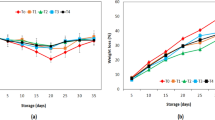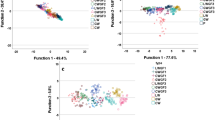Abstract
The aim of this study was to evaluate the possibility of using inhomogeneous sucrose distribution in cake formulations without changing the perceived sweetness of cakes with high sucrose content. For this purpose, control cake, 15% and 25% reduced sucrose content homogenous and inhomogeneous cake formulations were evaluated. In order to obtain inhomogeneous sucrose distribution in cakes the batter was prepared with different sucrose content and they were poured to the cake mould as three layers. The hardness values of the samples with inhomogeneous sucrose distribution (25.12 N and 25.39 N for 15% and 25% reduced sucrose content cakes with inhomogeneous distribution, respectively) were higher than the control sample (14.84 N) and homogeneous sucrose distribution cakes (18.50 N and 15.71 N for 15% and 25% reduced sucrose content cake with homogeneous distribution, respectively). However, there were no difference between springiness, cohesiveness and resilience values. The cooking losses were increased with inhomogeneous sucrose distribution (15.98 N and 15.40 N for 15% and 25% reduced sucrose content cakes with homogeneous distribution, respectively); on the other hand specific volume values of sucrose reduced cakes with homogeneous and inhomogeneous sucrose distribution were not different. As a result of sensory evaluation, the hardness of the samples was perceived as the same. The sweetness of inhomogeneous formulations with 15% reduced sucrose content was the same as the control sample and higher than homogeneous formulation with 15% reduced sucrose content. In terms of overall liking, inhomogeneous formulation with 15% reduced sucrose content was liked as same as the control sample. In this study it was revealed that the sucrose content could be reduced by 15% without changing the perceived sweetness in the cakes with inhomogeneous sucrose distribution.



Similar content being viewed by others
References
M. Schirmer, M. Jekle, E. Arendt, T. Becker, Physicochemical interactions of polydextrose for sucrose replacement in pound cake. Food Res. Int. 48(1), 291–298 (2012)
S. Martínez-Cervera, T. Sanz, A. Salvador, S.M. Fiszman, Rheological, textural and sensorial properties of low-sucrose muffins reformulated with sucralose/polydextrose. LWT-Food Sci. Technol. 45(2), 213–220 (2012)
Y. Hao, F. Wang, W. Huang, X. Tang, Q. Zou, Z. Li, A. Ogawa, Sucrose substitution by polyols in sponge cake and their effects on the foaming and thermal properties of egg protein. Food Hydrocoll. 57, 153–159 (2016)
D. Kocer, Z. Hicsasmaz, A. Bayindirli, S. Katnas, Bubble and pore formation of the high-ratio cake formulation with polydextrose as a sugar-and fat-replacer. J. Food Eng. 78(3), 953–964 (2007)
E. Wilderjans, A. Luyts, K. Brijs, J.A. Delcour, Ingredient functionality in batter type cake making. Trends Food Sci. Technol. 30(1), 6–15 (2013)
S.S. Kim, C.S. Setser, Wheat starch gelatinization in the presence of polydextrose or hydrolyzed barley beta-glucan. Cereal Chem. 69, 447–452 (1992)
M. Farzi, M.M. Saffari, Z. Emam-Djomeh, Effects of sugar, starch and HPMC concentrations on textural properties of reduced-sugar sponge cakes. J. Food Sci. Technol. 52(1), 444–450 (2015)
World Health Organisation (WHO), Cardiovascular diseases (CVDs), https://www.who.int/mediacentre/factsheets/fs317/en/. Accessed 19 Dec 2018
N.C.O. de Souza, L.D.L. de Oliveira, E.R. de Alencar, G.P. Moreira, Leandro E. dos Santos, V.C. Ginani, R.P. Zandonadi, Textural physical and sensory impacts of the use of green banana puree to replace fat in reduced sugar pound cakes. LWT- Food Sci. Technol. 89, 617–623 (2018)
WHO. Food based dietary guidelines in the WHO European Region, https://www.euro.who.int/__data/assets/pdf_file/0017/150083/E79832.pdf. Accessed 22 Jan 2019
Z. Hicsasmaz, Y. Yazgan, F. Bozoglu, Z. Katnas, Effect of polydextrose-substitution on the cell structure of the high-ratio cake system. LWT- Food Sci. Technol. 36(4), 441–450 (2003)
S.D. Lin, C.F. Hwang, C.H. Yeh, Physical and sensory characteristics of chiffon cake prepared with erythritol as replacement for sucrose. J. Food Sci. 68(6), 2107–2110 (2003)
H.A. Khouryieh, F.M. Aramouni, T.J. Herald, Physical and sensory characteristics of no-sugar-added/low-fat muffin. J. Food Qual. 28(5–6), 439–451 (2005)
F. Ronda, M. Gómez, C.A. Blanco, P.A. Caballero, Effects of polyols and nondigestible oligosaccharides on the quality of sugar-free sponge cakes. Food Chem. 90(4), 549–555 (2005)
A. Akesowan, Quality of reduced-fat chiffon cakes prepared with erythritolsucralose as replacement for sugar. Pak. J. Nutr. 8(9), 1383–1386 (2009)
G. Manisha, C. Soumya, D. Indrani, Studies on interaction between stevioside liquid sorbitol hydrocolloids and emulsifiers for replacement of sugar in cakes. Food Hydrocoll. 29(2), 363–373 (2012)
S. Martínez-Cervera, A. Salvador, T. Sanz, Comparison of different polyols as total sucrose replacers in muffins: thermal rheological texture and acceptability properties. Food Hydrocoll. 35, 1–8 (2014)
J. Rodríguez-García, A. Salvador, I. Hernando, Replacing fat and sugar with inulin in cakes: bubble size distribution physical and sensory properties. Food Bioprocess Technol. 7(4), 964–974 (2014)
J. Gao, M.A. Brennan, S.L. Mason, C.S. Brennan, Effect of sugar replacement with stevianna and inulin on the texture and predictive glycaemic response of muffins. Int. J. Food Sci. Technol. 51(9), 964–974 (2016)
S. Struck, L. Gundel, S. Zahn, H. Rohm, Fiber enriched reduced sugar muffins made from iso-viscous batters. LWT-Food Sci. Technol. 65, 32–38 (2016)
A.C. Mosca, F. van de Velde, J.H. Bult, M.A. van Boekel, M. Stieger, Enhancement of sweetness intensity in gels by inhomogeneous distribution of sucrose. Food Qual and Pref. 21(7), 837–842 (2010)
A.C. Mosca, F. van de Velde, J.H. Bult, M.A. van Boekel, M. Stieger, Effect of gel texture and sucrose spatial distribution on sweetness perception. LWT-Food Sci. Technol. 46(1), 183–188 (2012)
AACC, American Association of Cereal Chemists. Approved Methods of the AACC, 10th edn. Methods 10.05, 10.91, 44.40 (AACC, St. Paul, 2000)
AOAC Association of Official Analytical Chemists, Official Methods of Analysis 1990 AOAC Official Methods of Analysis (AOAC, Virginia, 1990)
F.M. Yılmaz, S.E. Bilek, Natural colorant enrichment of apple tissue with black carrot concentrate using vacuum impregnation. Int. J. Food Sci. Technol. 52(6), 1508–1516 (2017)
G. Ateş, Y. Elmacı, Coffee silverskin as fat replacer in cake formulations and its effect on physical, chemical and sensory attributes of cakes. LWT-Food Sci. Technol. 90, 519–525 (2018)
S. Martínez-Cervera, A. Salvador, T. Sanz, Cellulose ether emulsions as fat replacers in muffins: rheological, thermal and textural properties. LWT - Food Sci. Technol. 63, 1083–1090 (2015)
G. Ateş, Y. Elmacı, Physical, chemical and sensory characteristics of fiber-enriched cakes prepared with coffee silverskin as wheat flour substitution. J. Food Meas. Charact. 13(1), 755–763 (2019)
SPSS for Windows, Version 16.0. Chicago, SPSS Inc. (2007)
XLSTAT Trial version, Statistical and data analysis solution (Addinsoft, Boston, 2019)
M. Bodart, R. de Peñaranda, A. Deneyer, G. Flamant, Photometry and colorimetry characterisation of materials in daylighting evaluation tools. Build. Environ. 43, 2046–2058 (2008)
S. Martínez-Cervera, E. de la Hera, T. Sanz, M. Gómez, A. Salvador, Effect of using erythritol as a sucrose replacer in making Spanish muffins incorporating xanthan gum. Food Bioprocess Technol. 5(8), 3203–3216 (2012)
J.N. Kim, S. Park, W.S. Shin, Textural and sensory characteristics of rice chiffon cake formulated with sugar alcohols instead of sucrose. J. Food Qual. 37(4), 281–290 (2014)
M. Gómez, E. Ruiz-Paris, B. Oliete, V. Pando, Modelling of texture evolution of cakes during storage. J. Texture Stud. 41, 17–33 (2010)
N.F. Rahmati, M.M. Tehrani, Influence of different emulsifiers on characteristics of eggless cake containing soy milk: modeling of physical and sensory properties by mixture experimental design. J. Food Sci. Technol. 51(9), 1697–1710 (2014)
W.T. Yamazaki, L.T. Kissell, Cake flour and baking research: a review. Cereal Food World 23, 114–116 (1978)
E.L. Almeida, A.L. Marangoni, C.J. Steel, Starches from non–conventional sources to improve the technological characteristics of pound cake. Ciencia Rural. 43(11), 2101–2108 (2013)
M. Gupta, A.S. Bawa, A.D. Semwal, Effect of barley flour incorporation on the instrumental texture of sponge cake. Int. J. Food Prop. 12(1), 243–251 (2009)
M.H.F. Felisberto, A.L.Wahanik, C.R. Gomes-Ruffi, M.T.P.S Clerici, Y.K. Chang, C.J. Steel Use of chia (Salvia hispanica L.) mucilage gel to reduce fat in pound cakes. LWT-Food Sci. Technol. 63(2), 1049-1055 (2015)
Acknowledgements
The authors wish to thank Sevgi ÖZÇALIŞKAN and Seda ÇAM for their technical assistance in the laboratory.
Author information
Authors and Affiliations
Corresponding author
Ethics declarations
Conflict of interest
The authors declare that they have no conflict of interest.
Additional information
Publisher's Note
Publisher's Note Springer Nature remains neutral with regard to jurisdictional claims in published maps and institutional affiliations.
Rights and permissions
About this article
Cite this article
Dadalı, C., Elmacı, Y. Reduction of sucrose by inhomogeneous distribution in cake formulation. Food Measure 13, 2563–2570 (2019). https://doi.org/10.1007/s11694-019-00176-7
Received:
Accepted:
Published:
Issue Date:
DOI: https://doi.org/10.1007/s11694-019-00176-7




